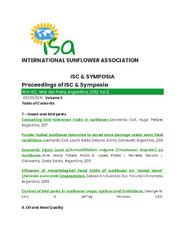Приказ основних података о документу
Is there appearance of new broomrape race in Serbia?
| dc.creator | Maširević, Stevan | |
| dc.creator | Medić-Pap, Slađana | |
| dc.creator | Škorić, Dragan | |
| dc.date.accessioned | 2022-05-05T08:59:29Z | |
| dc.date.available | 2022-05-05T08:59:29Z | |
| dc.date.issued | 2012 | |
| dc.identifier.uri | http://fiver.ifvcns.rs/handle/123456789/2608 | |
| dc.description.abstract | Broomrape in sunflower fields in Serbia has been appearing with a varying intensity almost every year. Yield losses depend on the intensity of the attack and they can range from 5 to 100 %. According to previous investigations of the broomrape population in Serbia, race E is dominant. In 2011 in several regions in Vojvodina (North part of Serbia) broomrape appearance on some sunflower hybrids which have resistance to races A-E was noticed. This phenomenon indicates the possibility of changes in the broomrape population in our country. o In order to determine changes in races, broomrape seeds were collected from the points (fields) where the attack in hybrids resistant to races A-E was noticed. Seed samples were kept in at the fridge on +4°C due to break dormancy. The reaction of some differential lines to the collected broomrape population was investigated in the greenhouse. Seed of differential lines was sown in plastic tubes in a mixture of sand and perlite. Before sowing sunflower seeds, broomrape seeds were put in tubes together with roots of susceptible sunflower genotype. The susceptibility or resistance of these lines to the collected broomrape population was evaluated on the presence of tubercles on sunflower roots. The presence of broomrape on hybrids resistant to race E was noticed primarily at points where for many years the sunflower hybrids resistance to races A-E has been tested. In those experimental fields sunflower has been cultivated every second year and that frequency of cultivation leads to inoculum increasing and higher selection pressure of broomrape to cultivated plant. Results obtained from the experiments in the green-house also indicate that there are some changes in broomrape population. o It should be pointed out that on resistant hybrids,the intensity of broomrape attack was low and could not significantly influence the yield. On the other hand in scientific and professional meaning, this is very important because the first appearance of broomrape plants with changed racial composition could be possibly an introduction to new period of its expansion and increasing of damages caused by this parasitic plant. These findings and observations are very important because of high practical importance of this parasitic plant and the fact that grown hybrids have low resistance level to new races. Another question is opened: Is this possibly new broomrape race present in Serbia identical to the new races present in Romania, Turkey or Spain or in some other regions in the world where this parasitic plant exists? The main problem is that other races except A-E are not determined strictly. The next step is the establishment of differential lines for separation of races 6, 7 etc., and on that way the results of scientist from different countries could be comparable. | sr |
| dc.language.iso | en | sr |
| dc.publisher | Paris : International Sunflower Association | sr |
| dc.rights | openAccess | sr |
| dc.rights.uri | https://creativecommons.org/licenses/by/4.0/ | |
| dc.source | Proceedings, 18th International Sunflower Conference, Mar del Plata & Balcarce, Argentina, 27 April - 1 March 2012 | sr |
| dc.subject | new race | sr |
| dc.subject | Orobanche | sr |
| dc.subject | Serbia | sr |
| dc.subject | sunflower | sr |
| dc.title | Is there appearance of new broomrape race in Serbia? | sr |
| dc.type | conferenceObject | sr |
| dc.rights.license | BY | sr |
| dc.identifier.fulltext | http://fiver.ifvcns.rs/bitstream/id/7203/bitstream_7203.pdf | |
| dc.identifier.rcub | https://hdl.handle.net/21.15107/rcub_fiver_2608 | |
| dc.type.version | publishedVersion | sr |


